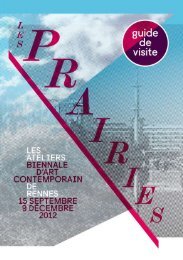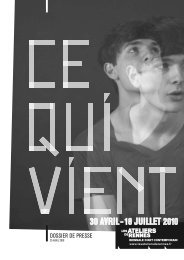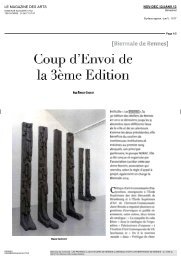Download here the Visitor's guide. - Les Ateliers de Rennes
Download here the Visitor's guide. - Les Ateliers de Rennes
Download here the Visitor's guide. - Les Ateliers de Rennes
Create successful ePaper yourself
Turn your PDF publications into a flip-book with our unique Google optimized e-Paper software.
56<br />
<strong>Les</strong> Prairies's artists<br />
IRENE KOPELMAN<br />
This is a potato, 2011. Courtesy of <strong>the</strong> artist.<br />
This project received support from fondation Botin, Santan<strong>de</strong>r.<br />
KITTY KRAUS<br />
The work presented in <strong>Les</strong> Prairies is emblematic of Kitty Kraus's<br />
interest in <strong>the</strong> processes and almost alchemical transformations<br />
associated with post-minimalist art, Arte Povera, and <strong>the</strong> artists<br />
Joseph Beuys and Robert Smithson. Her lamps encased in blocks of<br />
ink-stained ice <strong>de</strong>al with <strong>the</strong> disappearance of form. The initial form<br />
– cubic, compact and minimal – looks like an explosive <strong>de</strong>vice. Once<br />
<strong>the</strong> lamp is switched on, <strong>the</strong> ice inevitably melts and <strong>the</strong> ink spreads<br />
across <strong>the</strong> floor to create an abstract landscape, an amorphous black<br />
stain. The creation of what appears to be an ordinary mechanical<br />
acci<strong>de</strong>nt is in fact a very precise business. In <strong>the</strong> process <strong>the</strong> artist<br />
gives a new take on recurrent motifs in <strong>the</strong> art history of <strong>the</strong> mid<br />
to late 20th century – stains, cubes, light. A sombre beauty is born<br />
from <strong>the</strong>se changes of form and in it, physical and metaphysical<br />
<strong>de</strong>struction coinci<strong>de</strong>. Never<strong>the</strong>less, although Kraus emphasises <strong>the</strong><br />
sensitive aspect of <strong>the</strong>se works, with <strong>the</strong>ir materials (glass, ice, light,<br />
mirrors) evoking <strong>the</strong> fragility and transience of things, she avoids <strong>the</strong><br />
trap of elegance and remains on a knife-edge.<br />
K. A. F. tr. J. H.<br />
Born in 1976 in Hei<strong>de</strong>lberg (Germany), lives and works in Berlin<br />
(Germany).<br />
Irene Kopelman is fascinated by <strong>the</strong> riches of natural<br />
history museums and also by <strong>the</strong> domestication<br />
of landscape peculiar to old Europe. Some of <strong>the</strong><br />
curiosities she likes to explore certainly bor<strong>de</strong>r on <strong>the</strong><br />
fantastic: those rare molluscs with an anti-clockwise<br />
shell, for example, or <strong>the</strong> asymmetric property<br />
known as chirality which in various branches of<br />
science characterises systems whose mirror images<br />
cannot be superposed. Hands and orchids fall into<br />
this category. However, in or<strong>de</strong>r to counteract <strong>the</strong><br />
abstraction of surrealist data, Irene Kopelman makes<br />
drawings. In systems biology, as in minimal and<br />
conceptual art which she occasionally cites, rules<br />
govern <strong>the</strong> generation of shapes. The principles of<br />
sameness and difference are <strong>de</strong>termining factors<br />
as <strong>the</strong>y make it possible to <strong>de</strong>tect <strong>the</strong> occurrence of<br />
i<strong>de</strong>ntities, as distinct from <strong>the</strong> repetition of i<strong>de</strong>ntical<br />
entities. Kopelman has stated that one of <strong>the</strong> principle<br />
problematic <strong>the</strong>mes of her work concerns <strong>the</strong><br />
"dynamics of difference and repetition: how things<br />
which are almost i<strong>de</strong>ntical at first sight prove also<br />
to be different if we look at <strong>the</strong>m long enough and<br />
carefully enough".<br />
H. M. tr. J. H.<br />
Born in 1976 in Cordobá (Argentina), lives and works<br />
in Amsterdam (Ne<strong>the</strong>rlands).<br />
Untitled, 2008. Collection Kadist Art Foundation, Paris.






